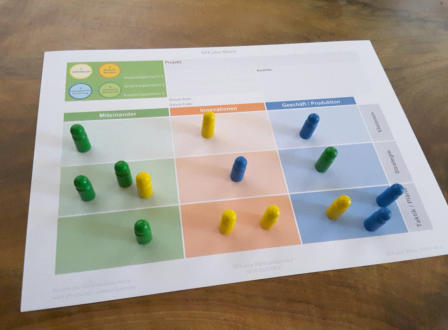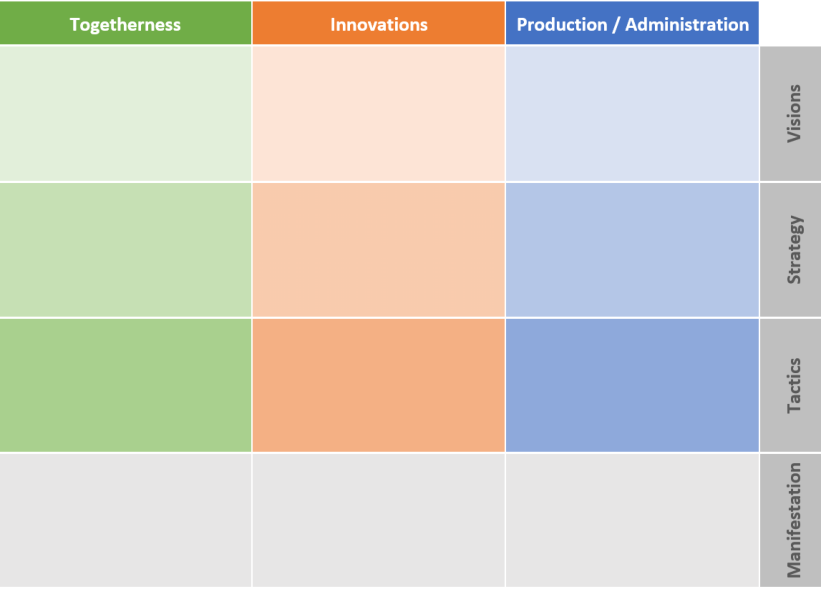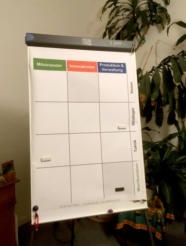NVC-plus Matrix

In
the
conventional
functional
structures
of
a
company,
employees
are
usually
fixed
to
their
defined
positions,
functions
and
roles.
In
conventional
matrix
organizations,
employees
can
already
switch
between
administrative
teams
(e.g.
workshop,
office,
sales)
and
project
teams
(project
1,
project
2,
project
3).
This
is
similar
to
what
we
do
at
NVC-plus
with
our
stable
home
teams
and
short-term
action-
based
teams.
In
conventional
companies
and
teams,
there
is
usually
a
central
controlling
position
that
is
often
represented
by
a
boss.
Agile
teams
try
to
go
one
step
further,
but
they
are
still
functional
teams.
At
NVC-plus,
we
do
without
centralized
control.
The
project
or
even
the
entire
company
is
self-organized.
Instead
of
central
management,
there
are
three
separate
management
areas,
which
can
be
traced
back
to
Rudolf
Steiner's
social
threefold
structure.
At
the
time,
Steiner
spoke
of
1)
law,
2)
spiritual
science
and
3)
the
economy.
We
have
translated
this
as
follows:
in
essence,
law
does
not
mean
the
administration
of
justice,
but
the
right
or
good
order
of
coexistence,
i.e.
what
is
actually
the
culture
of
coexistence.
The
humanities
bring
innovation
and
development
into
play.
Through
it,
the
all-important
creativity
comes
into
play
as
an
influx
of
new,
expressive
vitality.
And
the
economy
is
the
active
implementation
of
productive
projects.
This
gives
us
our
tripartite
division
into
cooperation,
innovation
and
the
production
of
a
company.
On
the
other
hand,
the
goals,
paths
and
implementation
of
people
also
come
into
play,
which
can
be
described
as
their
visions,
strategies
and
tactical
executions.
The
following
matrix
results
from
the
liveliness
of
the
people
and
the
structures
that
manifest
themselves
in
this
way
(move/tap
the
mouse
over
the
fields):
The
control
area:
Three
control
centers
and
three
types
of
work
on
them
-
this
results
in
9
colored
fields to which all team members can contribute freely at any time.
The
manifestation
area:
The
bottom
three
gray
manifestation
fields
show
the
areas
of
practical
work and results.

You
can
also
simply
use
the
NVC-plus
matrix
as
a
diagnostic
and
forecasting
tool
if
you
don't
want
to
use
it
for
self-management.
The
NVC-plus
matrix
can
be
easily
displayed
as
a
worksheet
in
a
spreadsheet
program.
You
can
fill
it
out
together.
Google
spreadsheets
may
be
suitable
for
virtual
conferences.
There
is
an
app
for
this
in
the
app
store
for
mobile
devices.
In
the
download
we
have
created,
we
have
also
included
further
detailed
worksheets
for
the
individual
areas.
Each
team
can
unleash
their
own
creativity and use the tools they are used to.
The
nine
control
fields
and
the
three
manifestation
fields
make
team
collaboration
self-organizing.
The
team
can
identify
its
blind
spots
and
initiate
the
appropriate
planning
steps
there.
Not
everything
that
later
manifests
itself
through
productive
work
is
produced
directly
by
the
team.
For
example,
the
tractor
compacts
the
soil
with
its
weight,
but
the
tractor
manufacturer
does
not
directly
cause
this
with
its
production.
The
compaction
is
manifested
by
driving
the
tractor
on
the
field.
The
manufacturer
can
look
at
this
and
try
to
develop
counter-concepts.
A
team
can
also
include
what
it
has
not
actively
produced
in
the
control
system
so
that
it
can
also
intervene
where
it
does
not
like
the
passive
effects
of
its
actions.
In
NVC-plus
teams,
we
focus
on
future-oriented
responsibility
instead
of
cultivating
past-oriented
ideas
of
guilt,
because
the
future can be changed.
The
tripartite
division
means
that
there
is
no
central
leadership
position.
This
does
not
mean
that
one
person
does
not
set
the
tone,
as
long
as
this
is
wanted
and
accepted.
But
there
is
no
central
position
for
it
and
so
this
person
will
behave
similarly
to
everyone
else:
Everyone
involved
will
switch
between
fields
according
to
their
inspiration,
impulse
and
perceived
meaningfulness.
These
changes
of
position
and
the
free
access
of
all
people
to
the
vision,
strategy
and
tactical
approach
bring
the
structure
to
life.
With
the
NVC-plus
four-step
circle,
chaos
is
avoided
and
people's
aspirations
synchronize
into
shared
visions,
strategies
and
tactics.
As
each
person
has
their
own
strengths,
weaknesses
and
preferences,
these
shifts
are
not
only
suitable
for
self-organizing
potential
to
where
it
is
needed,
but
also
for
learning
from
each
other,
supporting
each
other
and
getting
to
know
each
other
better.
By
gradually
introducing
the
NVC-plus
matrix
as
part
of
smaller
projects,
the
necessary
understanding
and
awareness can easily develop.
For
a
good
project
start,
the
NVC-plus
matrix
is
first
filled
out
as
a
project
matrix.
Not
everyone
needs
to
be
involved,
as
you
can
always
intervene
later
to
make
changes.
When
it
comes
to
an
inspiring
initial
vision,
a
good
initial
strategy
or
optimal
tactics,
it
helps
to
sit
down
with
the
right
people
and
then
make
the
preliminary
results
available
to
everyone.
This
reduces
the
communication
effort
and
makes
teamwork
more
effective.
If
you
also
apply
the
four-step
circle,
it
works
even
better.
Incidentally,
the
NVC-plus
matrix
is
always
provisional
as
a
control
matrix, otherwise the work would no longer be self-organized and interactively intelligent.


How to turn your team
into the boss



- The 6 Hurdles
- The Elements
- What are the Elements
- Culture Stage Model
- Gut, Head or Herart Process
- Culture Change
- List of Feelings and Needs
- Emergency Emo-Step
- Four Step Circle
- NVC Magic Circle
- Utopia Magic Circle
- Utopia and Vision
- No-Goes and Must-Haves
- Pain Points
- Consensus
- Requirement Lists
- NVC-plus Strategy
- NVC-plus Matrix
- Discourse
- Card Set
- Download-Tool-Depot
- FAQs
- Events
- Media
6 Hurdles to Self-Organization
Chapter 28 - The NVC-plus Matrix



Home / hurdle 6: integral management / nvc-plus matrix

Successful
cooperation
is
both
a
path
and
a
goal.
Good
methods
and
tools
make
it
much
easier
for
a
team
to
organize
itself.
Encourage
your
team
to
take
the
first
steps
in
this
direction
and
experience the difference.
The common organization board

Every team, start-up, or company must overcome these six hurdles if it wants to organize itself
collegially in order to successfully manage projects from within the community.
NVC-plus Matrix
In
the
conventional
functional
structures
of
a
company,
employees
are
usually
fixed
to
their
defined
positions,
functions
and
roles.
In
conventional
matrix
organizations,
employees
can
already
switch
between
administrative
teams
(e.g.
workshop,
office,
sales)
and
project
teams
(project
1,
project
2,
project
3).
This
is
similar
to
what
we
do
at
GFK-plus
with
our
stable
home
teams
and
short-term
action-based
teams.
In
conventional
companies
and
teams,
there
is
usually
a
central
controlling
position
that
is
often
represented
by
a
boss.
Agile
teams
try
to
go
one
step
further,
but
they
are
still
functional
teams.
At
GFK-plus,
we
do
without
centralized
control.
The
project
or
even
the
entire
company
is
self-organized.
Instead
of
central
management,
there
are
three
separate
management
areas,
which
can
be
traced
back
to
Rudolf
Steiner's
social
threefold
structure.
At
the
time,
Steiner
spoke
of
1)
law,
2)
spiritual
science
and
3)
the
economy.
We
have
translated
this
as
follows:
in
essence,
law
does
not
mean
the
administration
of
justice,
but
the
right
or
good
order
of
coexistence,
i.e.
what
is
actually
the
culture
of
coexistence.
The
humanities
bring
innovation
and
development
into
play.
Through
it,
the
all-
important
creativity
comes
into
play
as
an
influx
of
new,
expressive
vitality.
And
the
economy
is
the
active
implementation
of
productive
projects.
This
gives
us
our
tripartite
division
into
cooperation,
innovation
and
the
production
of
a
company.
On
the
other
hand,
the
goals,
paths
and
implementation
of
people
also
come
into
play,
which
can
be
described
as
their
visions,
strategies
and
tactical
executions.
The
following
matrix
results
from
the
vitality
of
the
people
and
the
structures
that
manifest
themselves in this way:
The
control
area:
Three
control
centers
and
three
types
of
work
on
them
-
this
results
in
9
colored
fields
to
which
all
team
members
can
contribute
freely
at
any time.
The
manifestation
area:
The
bottom
three
gray
manifestation
fields
show
the
areas
of
practical
work
and results.
You
can
also
simply
use
the
NVC-plus
matrix
as
a
diagnostic
and
forecasting
tool
if
you
don't
want
to
use
it
for
self-management.
The
NVC-plus
matrix
can
be
easily
displayed
as
a
worksheet
in
a
spreadsheet
program.
You
can
fill
it
out
together.
Google
spreadsheets
may
be
suitable
for
virtual
conferences.
There
is
an
app
for
this
in
the
app
store
for
mobile
devices.
In
the
download
we
have
created,
we
have
also
included
further
detailed
worksheets
for
the
individual
areas.
Each
team
can
unleash
their
own
creativity
and use the tools they are used to.
The
nine
control
fields
and
the
three
manifestation
fields
make
team
collaboration
self-organizing.
The
team
can
identify
its
blind
spots
and
initiate
the
appropriate
planning
steps
there.
Not
everything
that
later
manifests
itself
through
productive
work
is
produced
directly
by
the
team.
For
example,
the
tractor
compacts
the
soil
with
its
weight,
but
the
tractor
manufacturer
does
not
directly
cause
this
with
its
production.
The
compaction
is
manifested
by
driving
the
tractor
on
the
field.
The
manufacturer
can
look
at
this
and
try
to
develop
counter-concepts.
A
team
can
also
include
what
it
has
not
actively
produced
in
the
control
system
so
that
it
can
also
intervene
where
it
does
not
like
the
passive
effects
of
its
actions.
In
NVC-plus
teams,
we
focus
on
future-oriented
responsibility
instead
of
cultivating
past-oriented
ideas
of
guilt, because the future can be changed.
The
tripartite
division
means
that
there
is
no
central
leadership
position.
This
does
not
mean
that
one
person
does
not
set
the
tone,
as
long
as
this
is
wanted
and
accepted.
But
there
is
no
central
position
for
it
and
so
this
person
will
behave
similarly
to
everyone
else:
Everyone
involved
will
switch
between
fields
according
to
their
inspiration,
impulse
and
perceived
meaningfulness.
These
changes
of
position
and
the
free
access
of
all
people
to
the
vision,
strategy
and
tactical
approach
bring
the
structure
to
life.
With
the
NVC-plus
four-step
circle,
chaos
is
avoided
and
people's
aspirations
synchronize
into
shared
visions,
strategies
and
tactics.
As
each
person
has
their
own
strengths,
weaknesses
and
preferences,
these
shifts
are
not
only
suitable
for
self-organizing
potential
to
where
it
is
needed,
but
also
for
learning
from
each
other,
supporting
each
other
and
getting
to
know
each
other
better.
By
gradually
introducing
the
NVC-plus
matrix
as
part
of
smaller
projects,
the
necessary
understanding
and
awareness
can easily develop.
For
a
good
project
start,
the
NVC-plus
matrix
is
first
filled
out
as
a
project
matrix.
Not
everyone
needs
to
be
involved,
as
you
can
always
intervene
later
to
make
changes.
When
it
comes
to
an
inspiring
initial
vision,
a
good
initial
strategy
or
optimal
tactics,
it
helps
to
sit
down
with
the
right
people
and
then
make
the
preliminary
results
available
to
everyone.
This
reduces
the
communication
effort
and
makes
teamwork
more
effective.
If
you
also
apply
the
four-
step
circle,
it
works
even
better.
Incidentally,
the
NVC-plus
matrix
is
always
provisional
as
a
control
matrix,
otherwise
the
work
would
no
longer
be
self-organized
and
interactively
intelligent.






c) NVC-plus Matrix


Chapter 28 - The NVC-plus Matrix


- The 6 Hurdles
- The Elements
- What are the Elements
- Culture Stage Model
- Gut, Head or Herart Process
- Culture Change
- List of Feelings and Needs
- Requirement Lists
- NVC Magic Circle
- Utopia Magic Circle
- Emergency Emo-Step
- Four Step Circle
- Utopia and Vision
- No-Goes and Must-Haves
- Pain Points
- Consensus
- NVC-plus Strategy
- NVC-plus Matrix
- Discourse
- Card Set
- Download-Tool-Depot
- FAQs
- Events
- Media
Successful
cooperation
is
both
a
path
and
a
goal.
Good
methods
and
tools
make
it
much
easier
for
a
team
to
organize
itself.
Encourage
your
team
to
take
the
first
steps
in
this
direction
and
experience
the
difference.
The teams need a common control
board












































